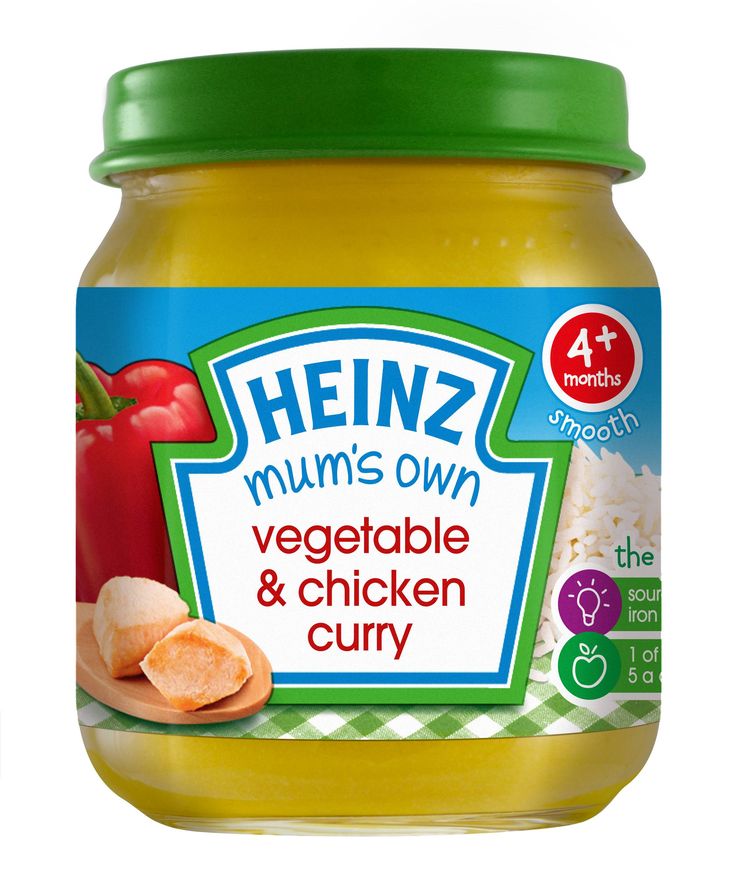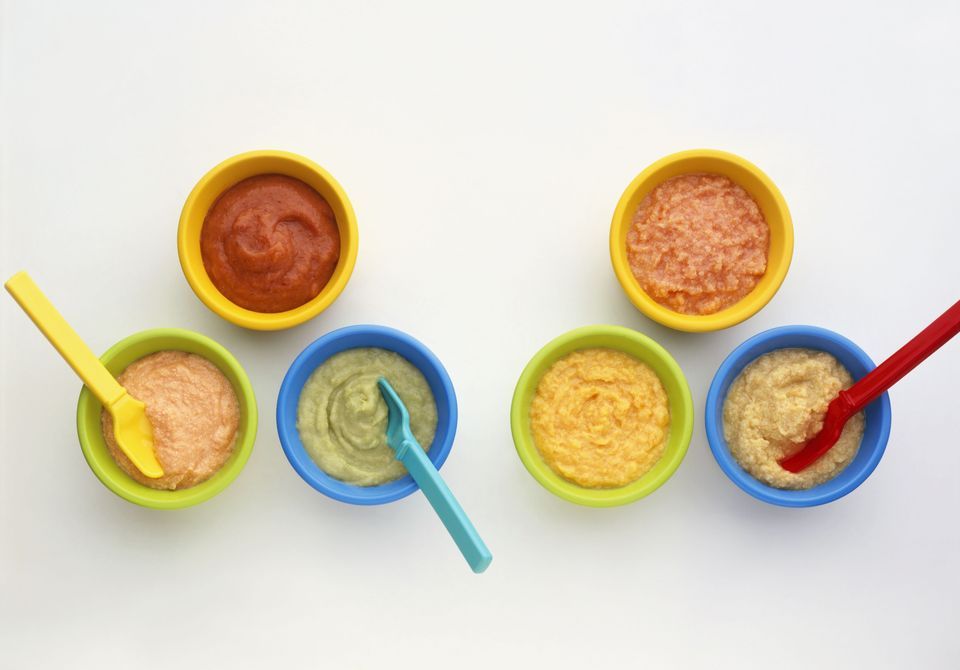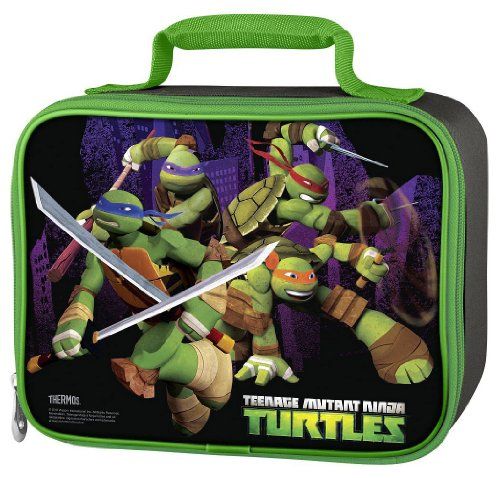How many times a day should 6 month old eat baby food
Feeding your baby: 6–12 months
At 6 months of age, breastmilk continues to be a vital source of nutrition; but it’s not enough by itself. You need to now introduce your baby to solid food, in addition to breastmilk, to keep up with her growing needs.
Be sure you give your baby her first foods after she has breastfed, or between nursing sessions, so that your baby continues to breastfeed as much as possible.
When you start to feed your baby solid food, take extra care that she doesn’t become sick. As she crawls about and explores, germs can spread from her hands to her mouth. Protect your baby from getting sick by washing your and her hands with soap before preparing food and before every feeding.
Your baby's first foods
When your baby is 6 months old, she is just learning to chew. Her first foods need to be soft so they’re very easy to swallow, such as porridge or well mashed fruits and vegetables. Did you know that when porridge is too watery, it doesn't have as many nutrients? To make it more nutritious, cook it until it’s thick enough not to run off the spoon.
Feed your baby when you see her give signs that she's hungry – such as putting her hands to her mouth. After washing hands, start by giving your baby just two to three spoonfuls of soft food, twice a day. At this age, her stomach is small so she can only eat small amounts at each meal.
The taste of a new food may surprise your baby. Give her time to get used to these new foods and flavours. Be patient and don’t force your baby to eat. Watch for signs that she is full and stop feeding her then.
As your baby grows, her stomach also grows and she can eat more food with each meal.
Feeding your baby: 6–8 months old
From 6–8 months old, feed your baby half a cup of soft food two to three times a day. Your baby can eat anything except honey, which she shouldn't eat until she is a year old. You can start to add a healthy snack, like mashed fruit, between meals. As your baby gets increasing amounts of solid foods, she should continue to get the same amount of breastmilk.
Feeding your baby: 9–11 months old
From 9–11 months old, your baby can take half a cup of food three to four times a day, plus a healthy snack. Now you can start to chop up soft food into small pieces instead of mashing it. Your baby may even start to eat food herself with her fingers. Continue to breastfeed whenever your baby is hungry.
Each meal needs to be both easy for your baby to eat and packed with nutrition. Make every bite count.
Foods need to be rich in energy and nutrients. In addition to grains and potatoes, be sure your baby has vegetables and fruits, legumes and seeds, a little energy-rich oil or fat, and – especially – animal foods (dairy, eggs, meat, fish and poultry) every day. Eating a variety of foods every day gives your baby the best chance of getting all the nutrients he needs.
If your baby refuses a new food or spits it out, don’t force it. Try again a few days later. You can also try mixing it with another food that your baby likes or squeezing a little breastmilk on top.
Feeding non-breastfed babies
If you're not breastfeeding your baby, she’ll need to eat more often. She'll also need to rely on other foods, including milk products, to get all the nutrition her body needs.
- Start to give your baby solid foods at 6 months of age, just as a breastfed baby would need. Begin with two to three spoonfuls of soft and mashed food four times a day, which will give her the nutrients she needs without breastmilk.
- From 6–8 months old, she’ll need half a cup of soft food four times a day, plus a healthy snack.
- From 9–11 months old, she’ll need half a cup of food four to five times a day, plus two healthy snacks.
6-Month-Old Feeding Schedule: A Doctor-Recommended Plan
Share on PinterestWe include products we think are useful for our readers. If you buy through links on this page, we may earn a small commission. Here’s our process.
6-month-old feeding schedule
If your 6-month-old is ready to start solid foods, you may be wondering how to do it. We explain the what, the when, and the how for feeding your 6-month-old.
We explain the what, the when, and the how for feeding your 6-month-old.
First of all, remember that at that age, breast milk or formula is still the prime source of nutrition for your infant.
Solid food is just a supplement at that age, and you should still feed your baby plenty of breast milk or formula.
Purchase formula for your baby online.
Often, the first food is baby cereal, like rice or oatmeal. Some babies won’t take cereal, and that’s OK.
There’s no harm in your baby skipping the cereal stage and going straight to pureed foods, but we do suggest trying cereal first. It has added iron, which your baby needs at this age.
Plus, it’s a nice bridge from the pure liquid diet of breast milk or formula to more solid food.
Here’s a selection of baby cereals to try.
Don’t put cereal in the bottle. Mix it with formula or water and give it with a spoon.
If you’re breastfeeding, don’t mix your breast milk with the cereal for the first few attempts at eating. Until your baby shows that they really will eat it, most of the cereal will wind up somewhere else besides their stomach, like on the floor, their head, or the tray.
Until your baby shows that they really will eat it, most of the cereal will wind up somewhere else besides their stomach, like on the floor, their head, or the tray.
Your breast milk is too valuable to throw away, so mix the cereal with a little water at first. When your infant is taking it well, then you can mix it with your breast milk.
Make the cereal a little runny at first, closer to the consistency of a liquid. If your baby is taking this well, gradually thicken it to the consistency of oatmeal.
Start by offering just a few spoonfuls at a time. When your baby has gotten the hang of it and seems to want more, work up to about 3 to 4 tablespoons per feeding.
Once your baby has been taking cereal reliably once a day for a week or two, try twice a day feedings. Once they’ve done that reliably for a week or two, then you can start pureed foods.
When your baby’s ready, start them on pureed baby foods like these.
Traditionally, orange and yellow vegetables have been the first foods to give a baby, but other good foods to try first are bananas or avocado.
When giving a food your baby hasn’t had before, give it at least three days in a row before trying another new food. This is to help identify which foods your baby may be allergic or intolerant to.
Also, be aware that many of your child’s later dietary habits often have their beginning in infancy. One study in 2014 found that babies who didn’t eat many fruits or vegetables in the 6- to 12-month period probably wouldn’t eat many fruits or vegetables as older children.
There are only a few foods you should not give your baby at this stage:
Raw honey
This can cause botulism in an infant. Wait until 12 months to give your child honey.
Cow’s milk
Babies shouldn’t be drinking cow’s milk at 6 months. But once they’re a little more advanced with solids, they can have some yogurt or soft cheese.
They may not be able to digest it properly, and it may cause microscopic bleeding into their stool.
Choking hazards
You can give your baby pureed or soft, cooked carrots, but not a big, round, chunk of carrot that they might choke on. This is true even if the food is not hard, such as whole grapes.
This is true even if the food is not hard, such as whole grapes.
Certain types of fish in excess
Avoid giving your baby certain types of fish that contain higher amounts of mercury more than once a month. This includes some forms of tuna and a few others.
Whitefish, salmon, and light canned tuna are usually safe to give more often. Talk to your doctor if you’re unsure of which kinds of fish are safe for your baby.
What else?
Unless there’s a very good reason — sometimes there are medical reasons to do so — it’s best to avoid giving your child juice at this age.
Even 100 percent natural fruit juice has a lot of sugar in it. Excessive sugar intake at this age has been linked to problems later on in life. Intake of sugar-sweetened drinks in infancy has been associated with double the risk of obesity at 6 years old.
You will notice that there are very few foods to avoid. Notably absent from the list are foods like eggs, peanut products, and strawberries.
Traditionally, pediatricians told parents to delay these foods, in hopes of preventing food allergies. But new research has shown that early introduction of these foods may actually help prevent allergies.
Remember, the foods need to be in a form that’s not a choking hazard. A tiny smidgen of creamy peanut butter on a banana, for example, is appropriate — but not a whole peanut.
Talk with your doctor if you’re worried about potential allergies due to a family history, or if your child may be having an allergic reaction (signs include a rash, vomiting, or diarrhea).
Call 911 immediately if your child is having severe symptoms such as trouble breathing.
The American Association of Pediatrics recommends delaying solids until 6 months old.
Starting on solids much earlier may cause your baby to breastfeed less, causing your breast milk to dry up sooner. Starting too early may also lead to a diet that’s low in protein, fat, and other nutrients.
On the other hand, don’t start solids much later than 6 months, as waiting too long can cause some problems with eating.
For some children, there’s a window of opportunity. If you wait too long to start solids, they don’t seem to “get it,” and may need a speech or occupational therapist to help them learn how to eat solids.
Remember that you’re slowly introducing solids to your baby, so there’s no need to move too fast.
Your infant is probably drinking breast milk or formula six to eight times a day at this stage. The goal, by age 1, is to get them to eat about six times a day:
- breakfast
- midmorning snack
- lunch
- midafternoon snack
- dinner
- pre-bedtime snack
Parents typically feed their child solids in the morning in the beginning, then add solids to the evening meal a little later. But, of course, you can feed your baby whenever you want.
We do recommend that if you’re giving a food for the first time, that you give it earlier in the day so you can see any reaction the child may have.
And don’t start the solids when the baby is famished and crying. If they’re in that state, feed them the breast milk or formula, but maybe not a whole feeding.
You want them to still have some room for the cereal. Then after the cereal, give them the rest of the breast milk or formula.
You can also try feeding them a little bit before their breast or bottle, at a time when they might be hungry enough to try solids, but not too hungry to be fussy.
There’s no wrong way to do this, so experiment, and see what your baby likes better.
When giving your baby solids, make sure they’re sitting upright in the high chair, belted in place. Make sure the tray is secure.
When giving cereal or pureed foods, put a little on the spoon, and put the spoon to the baby’s mouth. Many babies will eagerly open their mouths and take the spoon. Some may need a little coaxing.
If they don’t open their mouth, put the spoon to their lips and see if they respond. Don’t ever force the spoon into their mouth.
Mealtimes should be pleasant, so don’t force your baby to eat if they don’t want to. If they refuse at first, it may be a sign that they’re not ready.
If they’ve been eating solids for a while and then refuse something, it may be that they don’t like that food or just aren’t interested. So follow their cues.
Talk to your doctor if your baby does not have an interest in taking solids after trying for a few weeks, or if they’re having problems with feeding such as choking, gagging, or vomiting.
Try to have the whole family eat together, as this has been shown to have positive effects on a child’s development and bonding with the family.
Diet for a 4-6 month old baby
Your baby is already 4 months old. He has noticeably grown up, become more active, is interested in objects that fall into his field of vision, carefully examines and reaches for them. The emotional reactions of the child have become much richer: he joyfully smiles at all the people whom he often sees more and more often, makes various sounds.
You are still breastfeeding your baby or have had to switch to mixed or formula feeding. The child is actively growing, and only with breast milk or infant formula, he can no longer always get all the necessary nutrients. And that means it's time to think about complementary foods.
The optimal time to start its introduction is between 4 and 6 months, regardless of whether the baby is receiving breast milk or formula. This is the time when children respond best to new foods. Up to 4 months, the child is not yet ready to perceive and digest any other food. And with the late introduction of complementary foods - after 6 months, children already have significant deficiencies of individual nutrients and, first of all, micronutrients (minerals, vitamins, long-chain polyunsaturated fatty acids, etc.). In addition, toddlers at this age often refuse new foods, they have delayed development of chewing skills for thick foods, and inadequate eating habits are formed. It is important to know that, no matter how strange it may seem at first glance, with a delayed appointment of complementary foods, allergic reactions more often occur on them.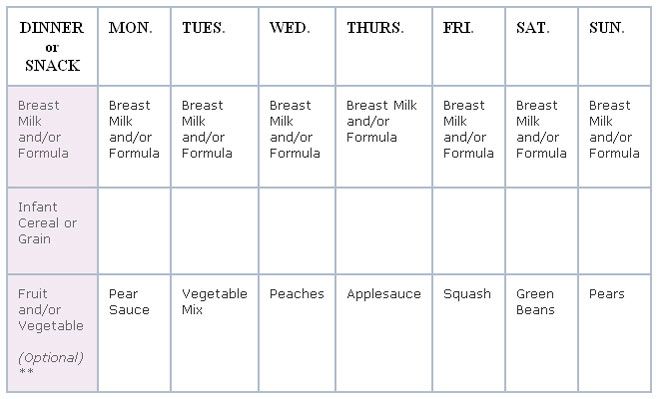
When is it advisable to introduce complementary foods as early as 4 months, and when can you wait until 5.5 or even 6 months? To resolve this issue, be sure to consult a pediatrician.
As a rule, at an earlier age (4 - 4.5 months), complementary foods are introduced to children at risk of developing iron deficiency anemia, as well as children with insufficient weight gain and with functional digestive disorders.
The optimal time to start complementary foods for a healthy baby is between 5 and 5.5 months of age.
The World Health Organization recommends that breastfed babies should be introduced to complementary foods from 6 months of age. From the point of view of domestic pediatricians, which is based on extensive practical experience and scientific research, this is possible only in cases where the child was born on time, without malnutrition (since in these cases the mineral reserves are very small), he is healthy, grows well and develops. In addition, the mother should also be healthy, eat well and use either specialized enriched foods for pregnant and lactating women, or vitamin and mineral complexes in courses. Such restrictions are associated with the depletion of iron stores even in a completely healthy child by 5-5.5 months of age and a significant increase in the risk of anemia in the absence of complementary foods rich or fortified with iron. There are other deficits as well.
Such restrictions are associated with the depletion of iron stores even in a completely healthy child by 5-5.5 months of age and a significant increase in the risk of anemia in the absence of complementary foods rich or fortified with iron. There are other deficits as well.
The first complementary food can be vegetable puree or porridge, fruit puree is better to give the baby later - after tasty sweet fruits, children usually eat vegetable puree and cereals worse, often refuse them altogether.
Where is the best place to start? In cases where the child has a tendency to constipation or he puts on weight too quickly, preference should be given to vegetables. With a high probability of developing anemia, unstable stools and small weight gains - from baby cereals enriched with micronutrients. And if you started introducing complementary foods with cereals, then the second product will be vegetables and vice versa.
If the first complementary food is introduced at 6 months, it must be baby porridge enriched with iron and other minerals and vitamins, the intake of which with breast milk is no longer enough.
Another important complementary food product is mashed meat. It contains iron, which is easily absorbed. And adding meat to vegetables improves the absorption of iron from them. It is advisable to introduce meat puree to a child at the age of 6 months. Only the daily use of children's enriched porridge and meat puree can satisfy the needs of babies in iron, zinc and other micronutrients.
But it is better to introduce juices later, when the child already receives the main complementary foods - vegetables, cereals, meat and fruits. After all, complementary foods are needed so that the baby receives all the substances necessary for growth and development, and there are very few in their juices, including vitamins and minerals.
Juices should not be given between feedings, but after the child has eaten porridge or vegetables with meat puree, as well as for an afternoon snack. The habit of drinking juice between meals leads to frequent snacking in the future, a love of sweets is instilled, children have more tooth decay and an increased risk of obesity.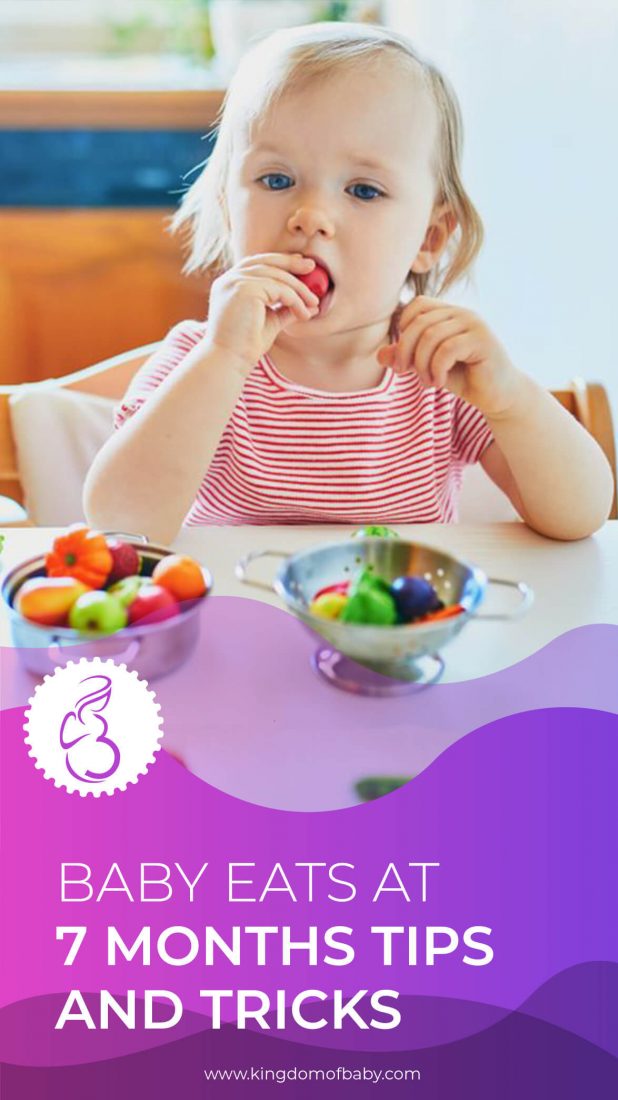
With the start of the introduction of complementary foods, the child is gradually transferred to a 5-time feeding regimen.
Rules for the introduction of complementary foods:
- preference should be given to baby products of industrial production, they are made from environmentally friendly raw materials, have a guaranteed composition and degree of grinding
- Complementary foods should be offered to the baby by spoon at the start of feeding, before breastfeeding (formula feeding)
- the volume of the product increases gradually, starting with ½ - 1 spoon, and in 7 - 10 days we bring it to the age norm, subsequent products within the same group (cereals from other cereals or new vegetables)
- can be entered faster, in 5 - 7 days
- start introduction with monocomponent products
- it is undesirable to give a new product in the afternoon, it is important to follow how the child reacts to it
- do not introduce new products in the event of acute illnesses, as well as before and immediately after prophylactic vaccination (should be abstained for several days)
When introducing a new type of complementary food, first try one product, gradually increasing its amount, and then gradually “dilute” this product with a new one. For example, vegetable complementary foods can be started with a teaspoon of zucchini puree. During the week, give the baby only this product, gradually increasing its volume. After a week, add a teaspoon of mashed broccoli or cauliflower to the zucchini puree and continue to increase the total volume every day. Vegetable puree from three types of vegetables will be optimal. The portion should correspond to the age norm. Over time, you can replace the introduced vegetables with others faster.
For example, vegetable complementary foods can be started with a teaspoon of zucchini puree. During the week, give the baby only this product, gradually increasing its volume. After a week, add a teaspoon of mashed broccoli or cauliflower to the zucchini puree and continue to increase the total volume every day. Vegetable puree from three types of vegetables will be optimal. The portion should correspond to the age norm. Over time, you can replace the introduced vegetables with others faster.
After the introduction of one vegetable (bringing its volume to the required amount), you can proceed to the intake of porridge, and diversify the vegetable diet later.
If the child did not like the dish, for example, broccoli, do not give up and continue to offer this vegetable in a small amount - 1-2 spoons daily, you can not even once, but 2-3 times before meals, and after 7 - 10, and sometimes 15 days, the baby will get used to the new taste. This diversifies the diet, will help to form the right taste habits in the baby.
Spoon-feeding should be done with patience and care. Forced feeding is unacceptable!
In the diet of healthy children, porridge is usually introduced after vegetables (with the exception of healthy breastfed children, when complementary foods are introduced from 6 months). It is better to start with dairy-free gluten-free cereals - buckwheat, corn, rice. At the same time, it is important to use porridge for baby food of industrial production, which contains a complex of vitamins and minerals. In addition, it is already ready for use, you just need to dilute it with breast milk or the mixture that the baby receives.
Children suffering from food allergies are introduced complementary foods at 5-5.5 months. The rules for the introduction of products are the same as for healthy children, in all cases it is introduced slowly and begins with hypoallergenic products. Be sure to take into account individual tolerance. The difference is only in the correction of the diet, taking into account the identified allergens. From meat products, preference should first be given to mashed turkey and rabbit.
From meat products, preference should first be given to mashed turkey and rabbit.
Diets for different age periods
Explain how you can make a diet, it is better to use a few examples that will help you navigate in compiling a menu specifically for your child.
From 5 months, the volume of one feeding is on average 200 ml.
Option 1.
If your baby started receiving complementary foods from 4-5 months, then at 6 months his diet should look like this:
| I feeding 6 hours | Breast milk or VHI* | 200 ml |
| II feeding 10 hours | Dairy-free porridge** Supplementation with breast milk or VHI* | 150 g 50 ml |
| III feeding 14 hours | Vegetable puree Meat puree Vegetable oil Supplemental breast milk or VHI* | 150 g 5 - 30 g 1 tsp 30 ml |
| IV feeding 18 hours | Fruit puree Breast milk or VHI* | 60 g 140 ml |
| V feeding 22 hours | Breast milk or VHI* | 200 ml |
* - infant formula
** - diluted with breast milk or VHI
Option 2.
* - infant formula Option 3. : ** - diluted with breast milk Up to 7 months, increase the volume of porridge and vegetable puree to 150 g and introduce fruit puree. The materials were prepared by the staff of the Healthy and Sick Child Nutrition Laboratory of the National Research Center for Children's Health of the Ministry of Health of Russia and are based on the recommendations given in the National Program for Optimizing the Feeding of Children in the First Year of Life in the Russian Federation, approved at the XV Congress of Pediatricians of Russia (02.2009d.) Breast milk is the best food for your baby. It is recommended to start introducing complementary foods into the baby's diet no earlier than 4 months, but no later than 6 months*. At this age, the baby is in the active phase of development and reacts with curiosity to everything new! Some babies at 4 to 5 months of age can no longer satisfy their appetite with breast milk alone and need complementary foods for healthy growth. If your baby spits out the first spoonfuls of puree, be patient. After all, he must first learn to swallow it. Start with a few scoops and give your child time to get used to the new form of feeding. *Recommendation of the Nutrition Committee of the European Society of Pediatric Gastroenterology, Hepatology and Nutrition (ESPGHAN) After 4-6 months of life, mother's milk or milk formula alone is not enough to supply the child's body with all the nutrients and necessary energy. Gradually replace one breastfeed with complementary foods. First for lunch, then for dinner and finally for lunch. The mouse eats breakfast with the usual dairy food. Starting complementary foods with HiPP products is easy. The first spoons will be vegetable or fruit purees HiPP: We recommend that you start complementary foods at lunchtime with HiPP vegetable puree (for example, "Zucchini. My first puree", "Cauliflower. My first puree" or "Broccoli .My first puree"). Then, for satiety, feed your baby as always: breast or bottle. The amount of vegetable puree can be increased daily by 1 spoon. Be patient if your baby does not immediately love vegetables. If your baby tolerates vegetables well, in the third week you can introduce grain porridge into the diet, and as a dessert, offer a few spoons of fruit puree enriched with vitamin C. Vitamin C helps to better absorb iron in the body. Once your baby starts eating a whole serving of mashed potatoes for lunch, you can eliminate breast milk or formula during that meal. Tip: Reheat as much puree as needed for feeding. Store leftover puree in a sealed jar in the refrigerator. Use the contents of the opened jar within a day. Important! If you are using a microwave, please remove the lid before heating the puree. Stir after heating. To prevent damage to the jar, please use only a plastic spoon. Always check food temperature before feeding. I feeding
6 hours Breast milk or VHI* 200 ml II feeding
10 hours Dairy-free porridge**
Fruit puree 150 g
20 g III feeding
14 hours Vegetable puree
Meat puree Vegetable oil
Fruit juice 150 g
5 - 30 g
1 tsp
60 ml IV feeding
18 hours Fruit puree
Breast milk or VHI* 40 g
140 ml V feeding
22 hours Breast milk or VHI* 200 ml
** - diluted with breast milk or VMS 
I feeding
6 hours Breast milk II feeding
10 hours Dairy-free porridge**
Breast milk supplement 100 g III feeding
14 hours Vegetable puree
Meat puree Vegetable oil
Breast milk supplement 100 g
5 - 30 g
1 tsp IV feeding
18 hours Breast milk V feeding
22 hours Breast milk 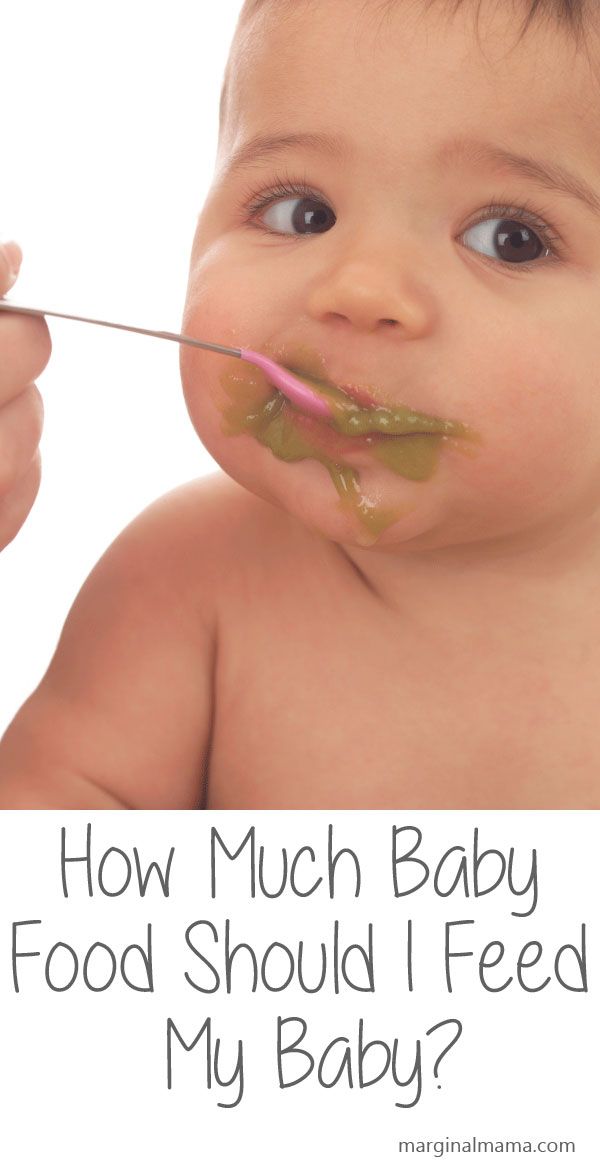
4 to 6 months
It is very important that the baby consumes breast milk for as long as possible. The right age to start complementary foods
 Other children have enough breast milk, and they are ready for the introduction of complementary foods only after 6 months. The decision to start complementary foods should always be made according to your baby's development. Do you feel like your baby is not getting enough breast milk? Does your baby hold his head on his own, show interest in new foods or a spoon? Then it's time to start feeding. If in doubt, consult your pediatrician.
Other children have enough breast milk, and they are ready for the introduction of complementary foods only after 6 months. The decision to start complementary foods should always be made according to your baby's development. Do you feel like your baby is not getting enough breast milk? Does your baby hold his head on his own, show interest in new foods or a spoon? Then it's time to start feeding. If in doubt, consult your pediatrician. Why is complementary foods important for the baby?
 In addition, the transition to solid food trains the muscles of the mouth. And finally, with the introduction of complementary foods, the child will get acquainted with the variety of taste directions, which is also important for his development.
In addition, the transition to solid food trains the muscles of the mouth. And finally, with the introduction of complementary foods, the child will get acquainted with the variety of taste directions, which is also important for his development. When to start complementary foods?
First step: lunch
 Try repeating the vegetable puree in the following days. Next week, you can expand your diet with other varieties of HiPP vegetables (for example, "Carrots. My first puree" or "Potatoes. My first puree").
Try repeating the vegetable puree in the following days. Next week, you can expand your diet with other varieties of HiPP vegetables (for example, "Carrots. My first puree" or "Potatoes. My first puree"). 


